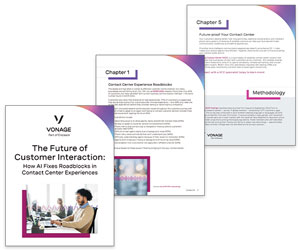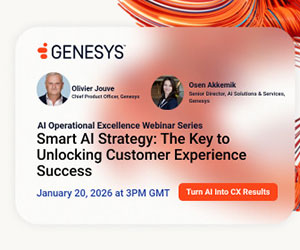Vonage explores what AI IVR is, how it works, and how it differs from traditional IVR systems. We’ll also explore the huge variety of benefits that implementing an AI IVR system could bring to your company.
AI IVR systems take the old IVR rulebook and throw it out the window. Leveraging the capabilities of modern AI and machine learning technology empowers you to deliver dazzling customer experiences that make you stand out from the competition.
What is AI IVR?
Interactive Voice Response – or IVR – is a technology that allows companies to automate call handling. Traditional IVR systems are menu-based, and you’re probably already familiar with them. If you’ve ever called a support service to be met with an automated greeting, you’ve likely interacted with an IVR.
The basic idea is simple. The system leads the caller through a tree of menu options from which they select using their voice or phone keypad.
Eventually, the customer either gets what they need using self-service resolution, or the call will be routed to a human agent.
Unfortunately, this can be a time-consuming and even frustrating process. You generally need to wait to hear all the options, and if you make a mistake, you might have to go back to the beginning and start all over again. Not ideal.
Luckily, there’s a solution: AI-based IVR.
With AI IVR, the system interacts with the caller in a much more natural way. That’s because call handling is a superb use case for AI.
AI’s ability to process natural language and determine caller intent makes for much more fluid interactions. To the human caller, the experience is more like having a conversation with a live agent rather than pushing a series of buttons.
AI IVR vs. Traditional IVR
| Traditional IVR | AI IVR | |
|---|---|---|
| Operated Via | Menu selection | Natural language |
| Learning Ability | None | Dynamic/Learns via interaction |
| Speech Recognition | Limited/keyword driven | Advanced/understands dialects |
| Call Routing | Triggered by input | Intelligent routing based on context |
| Personalisation | None | Based on context and caller history |
| Resolution Capability | Simple queries only | Simple and complex queries |
| Caller Experience | Time-consuming and rigid | Quick and user-friendly |
How Conversational AI IVR Works
AI IVR solutions use a four-step process to determine caller intent and resolve customer queries — automatic speech recognition, natural language processing, decision logic, and text-to-speech. Let’s look at these steps in a little more detail.
1. Automatic Speech Recognition (ASR)
When the customer begins to speak, the AI processes the audio and converts it into text. This happens so quickly that the caller won’t be able to detect any delay.
2. Natural Language Processing (NLP)
NLP is a sophisticated technology that enables the AI to understand what the caller wants. Advances in NLP constituted the crucial breakthrough for IVR AI.
For a long time, variations in accent, dialect, and the kinds of natural pauses and hesitations that occur frequently in speech prevented automated systems from grasping spoken conversation accurately. However, today’s AI systems understand a wide variety of speech patterns.
3. Decision Logic and Backend Integrations
The next step is what you might call the “brain of the operation.” Once the AI has established caller intent, it draws on all the resources at its disposal to find the answer to the query. Alternatively, the AI may decide to route the call to a live agent who can provide more appropriate assistance.
In making this decision, the AI normally interacts with other business systems via APIs. For instance, it might use a CRM integration to access information about the caller’s history with the company.
4. Text-to-Speech (TTS)
Finally, all that remains for the AI to do is convert the information into a usable format for the caller. In other words, it talks to them.
The AI uses TTS technology to generate natural-sounding speech to bring the caller up to date and carry on the conversation.
Benefits of AI in IVR Systems
There are many advantages to equipping IVR with AI, including some that go beyond the basics of call management. Here’s a quick overview of six clear benefits you’ll experience after your company makes the switch.
High Contextualization
One area where AI is useful is quickly establishing the context of a customer’s call. Since it has access to a wide range of data, it can select the relevant information as soon as the customer starts talking.
For example, if a customer calls to complain about non-delivery of an order, the AI will begin by looking up the relevant order history in your CRM. But it will also be able to detect customer sentiment.
That’s crucial because there’s a huge difference between a customer making a calm request and one who is audibly angry.
In the latter case, you could authorize the AI to offer additional compensation to reduce the risk of the customer churning.
Smart, Precise Call Routing
Similarly, an AI-powered IVR system can determine how best to route a call, depending on context. For instance, it would match a customer calling to request more information about a complex product with an agent expert in that area.
This is important because it eliminates the problem of customers being passed multiple times before they get the answers they need. The result is an increase in first-call resolution rates and customer satisfaction levels.
Continuous, Uninterrupted Interactions
Another aspect of AI IVR that makes the customer experience much better is its ability to carry on conversations across different channels. It can do this because it remembers previous interactions.
This can be useful if, for example, the AI would like to showcase products the customer might be interested in via a visual medium.
It can suggest switching the conversation to a messaging platform and continuing from there. And of course, there’s the occasional issue of inadvertent disconnection. If that happens, the caller can simply call back and pick up the conversation where they left off.
Workforce Oversight
Maximizing efficiency in a call centre can be challenging, particularly from the point of view of workforce allocation. As call volumes rise and fall, it can be difficult to deploy your teams effectively.
Luckily, AI IVR systems provide detailed call analytics that can help. The insights the system generates can help you be more strategic about creating schedules with the necessary flexibility, while ensuring all bases are covered.
Ongoing Growth and Improvement
A major benefit of IVR AI is that it learns as it goes along. Every interaction is a learning opportunity. If a response doesn’t quite hit the mark, it learns from its mistakes so that the next time it’s faced with a similar situation, it can give a better one.
And remember, this happens continuously whenever it interacts with a caller. Over time, the system becomes more attuned to customer needs, so it can deliver even better service.
Enduring Connection
AI IVRs are completely different from traditional automated response systems. As they are capable of integrated data processing and natural interactions, they can engage customers like a human agent.
This means they can continue a conversation even after resolving the original query. For instance, if the AI IVR judges a customer to be in a receptive frame of mind, it might see an opportunity for a little cross-selling and make suggestions accordingly.
Applications of AI in IVR For Businesses
AI is such a versatile tool that there’s a large variety of ways you can use it to boost your business. These include:
Customer Support
As we’ve been exploring, an AI can help answer customer queries while interacting using natural-sounding speech. It can deal with more complex issues and questions than old menu-based systems.
Outbound campaigns: The AI IVR generator technology is as useful for outbound calls as inbound ones. You can also leverage the detailed call analytics it provides to help segment your customer base more effectively, so that you can create more targeted campaigns.
Regulatory compliance: If your business operates in a field with strict regulatory requirements, AI can be configured to ensure you remain compliant in all your communications. You can ask it to flag any instances of compliance breaches and rectify them automatically.
How to Calculate the ROI of AI IVR Solutions
Using conversational AI in your IVR system has several benefits, but, as with any business decision, you must measure its effect on the bottom line.
The simplest way of doing this is to track certain key metrics across the implementation phase. Successful deployment of your AI IVR system will generally lead to improvements in these metrics, in particular:
- First-call resolution rate
- Average call handling times
- Customer satisfaction
Overall, you should experience a drop in operational costs as well. That’s mainly because AI will be able to handle much more complex issues than a traditional IVR system, so you won’t need to hire as many human agents, resulting in reduced labour costs.
What Are the Challenges of Implementing AI in IVR?
It’s worth looking at some potential difficulties you might encounter when deploying an AI IVR system. Here are a few common challenges you could face:
Lack of Integration With Existing Systems
To get the full benefit of an AI IVR system, it has to be well integrated into your existing systems. After all, if the AI can’t easily access your CRM, it won’t be able to find out anything about your customers. This can require some deep backend integration, so it’s essential to focus on this when selecting a solution.
Poor Data Quality
“Garbage in, garbage out” applies here. AI can only work with the data it’s given. If your data is inaccurate, the AI’s output will be, too.
Potential for Hallucinations
Conversational AI is improving all the time, but it’s still not possible to guarantee it won’t occasionally invent facts and present them as real.
There are ways to tackle this, of course. Specifically, as long as you implement a rigorous oversight system, it shouldn’t be a serious issue.
Maintaining Consistency
One of the great strengths of AI is that it’s so flexible in how it operates. But this can also be a drawback when it comes to ensuring the service it provides is completely consistent in terms of quality, particularly for the most complicated queries.
How to Implement AI in IVR – Practical Tips
What’s the best way to tackle these challenges to ensure the success of your AI IVR deployment? Here are the steps to follow to help you achieve just that.
- Set your goals: What do you want to achieve with the implementation? Be specific. For example, you might want to focus on increasing first-call resolution rates or reducing instances of misrouting.
- Select the right platform: Consider factors such as integrations with your existing systems, the level of customization available, and whether you need a multilingual system for international business.
- Create a customer journey catalog: Develop models of customer interaction pathways to train the AI. This should include all common query types, such as product information requests, account-related questions, or payment processing.
- Integrate the AI with your existing systems: Now it’s time to plug the AI into your data sources. If you’re already using a Unified Communications platform, this stage should be relatively straightforward, but it’s important, so don’t rush it.
- Test: Once the AI is connected to your other systems, it’s time to begin the testing phase. Check how the AI performs on a range of query types, then fine-tune as required.
- After-launch monitoring: Regular monitoring of the AI IVR system’s performance is essential to make sure it’s providing your customers with the best possible service.
What Trends Are Emerging in the Field of AI IVR?
As the technology behind AI IVR systems continues to develop, many key trends are emerging. What they have in common is that they’re all aimed at improving the customer experience as much as possible. Here are a few examples:
Hyper-Personalization
We’ve come a long way from being required to choose from a small number of fixed options. The contextual understanding and lightning-fast data processing powers of modern AI systems have made it possible for them to offer advice and support perfectly tailored to each customer’s needs.
More Human-Like Interactions
Thanks to advances in machine learning and NLP technology, the experience of talking to an AI on the phone is becoming less and less like talking to a robot and much more like interacting with a live agent.
It’s got to the point where it’s important to let your customers know in advance that they’re interacting with an AI. That’s because sometimes customers find it difficult to tell the difference, which has implications for user trust.
Omnichannel Integration
Many companies are now using AI not only in their IVR system for voice calls, but also across different channels. This means it’s much easier to keep the conversation going with customers who may prefer to connect on another platform.
What Features Should the Best AI IVR Solutions of 2025 Include?
There is a growing number of AI IVR solutions on the market, but they’re not all created equal. In 2025, any top-end solution should include these features:
An Excellent AI Engine
It’s crucial to get the basics right. Any AI IVR product worth buying has to be built on an AI that excels in natural language interaction, discerning customer intent from context, and delivering consistently high-quality responses.
Straightforward Setup
Deploying AI has challenges, but it doesn’t have to be a headache. Opt for solutions that emphasize usability and intuitive configuration processes.
Omnichannel Capability
Given that more and more customer support interaction happens on channels other than voice calls, modern AI IVR systems should be able to deal with customers across other channels, such as SMS and messaging platforms like WhatsApp.
This blog post has been re-published by kind permission of Vonage – View the Original Article
For more information about Vonage - visit the Vonage Website
Call Centre Helper is not responsible for the content of these guest blog posts. The opinions expressed in this article are those of the author, and do not necessarily reflect those of Call Centre Helper.
Author: Vonage
Reviewed by: Jo Robinson
Published On: 28th Jul 2025
Read more about - Guest Blogs, Vonage






 Vonage is redefining business communications, helping enterprises use fully-integrated unified communications, contact centre and programmable communications solutions via APIs.
Vonage is redefining business communications, helping enterprises use fully-integrated unified communications, contact centre and programmable communications solutions via APIs. 


































